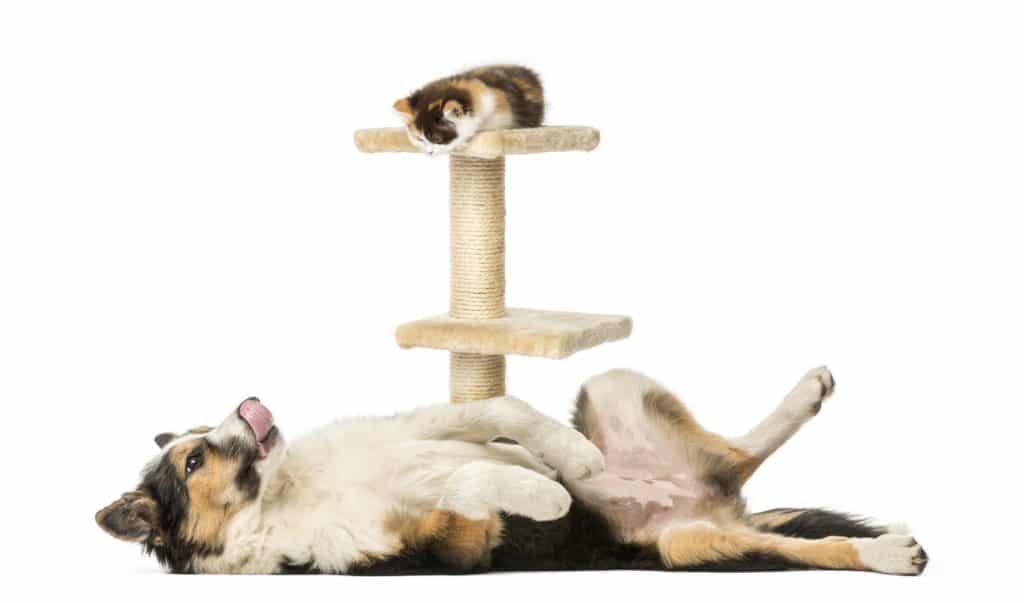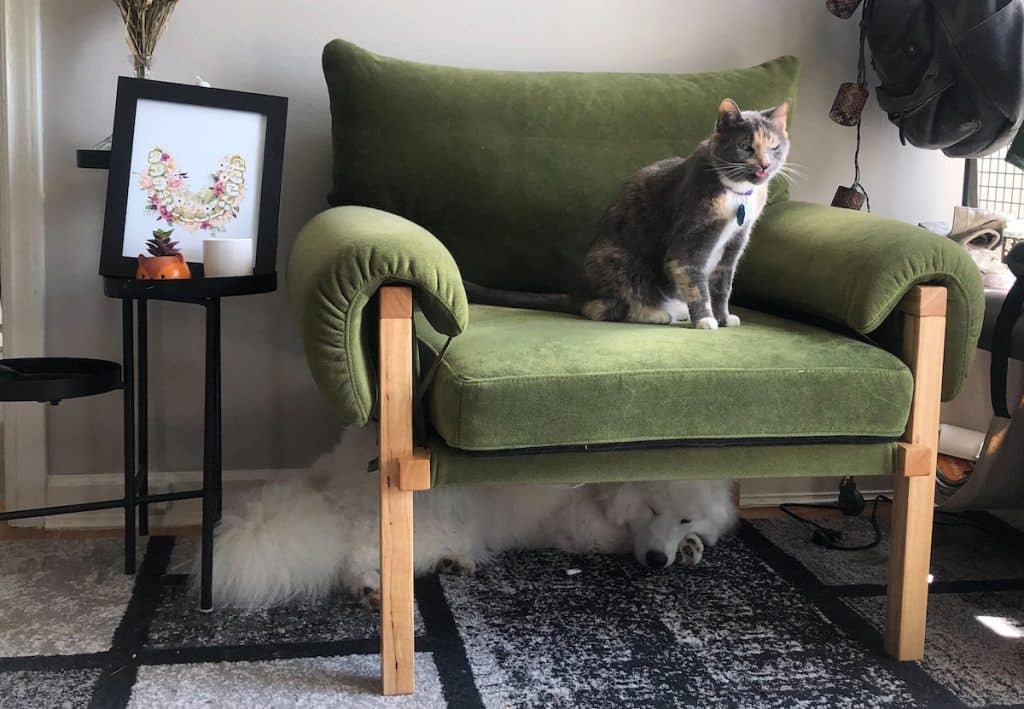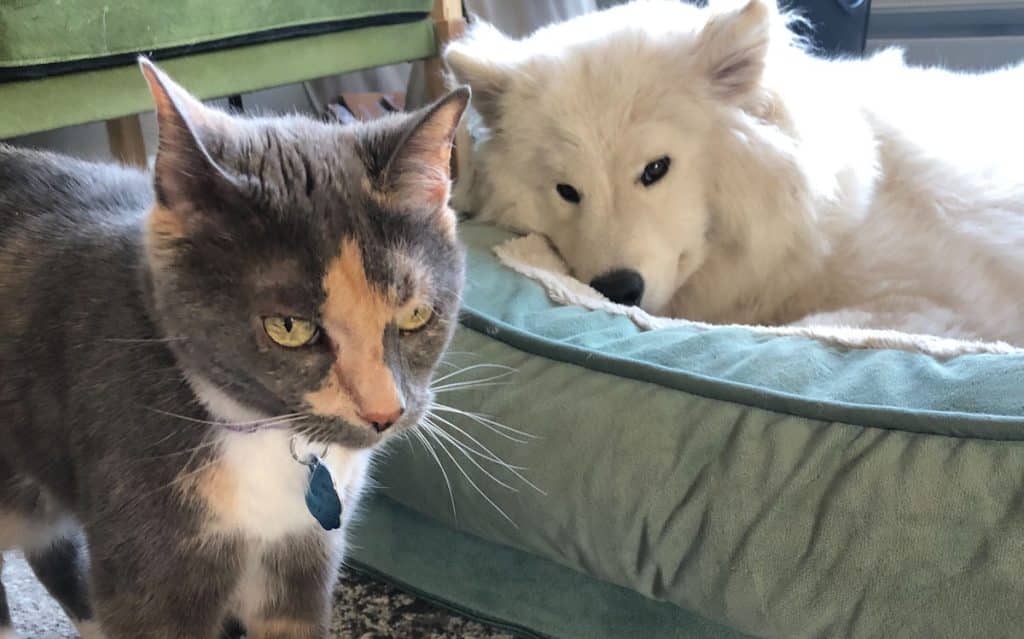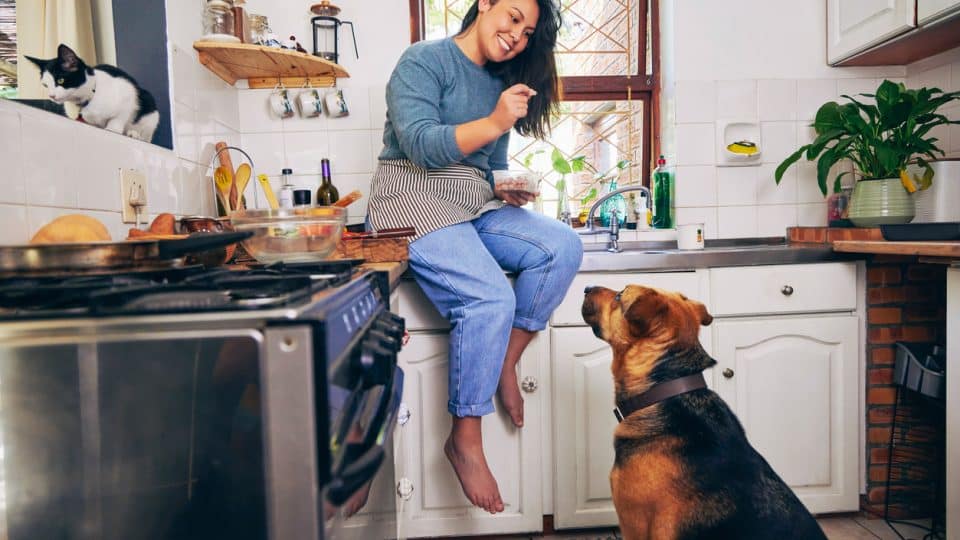Flighty, feisty, and fast—these catty characteristics can trigger many reactions in a dog. But of these reactions, signs of hyper-fixation and aggression towards cats are the ones to look out for.
“Dog aggressiveness nearly always has a reason,” says Dr Alex Schechter, DVM, of veterinary hospital, Burrwood Veterinary. “A lot of people think that it’s natural for dogs to want to chase something that moves, but it all depends on how they’re raised.” While knowing your dog’s background is ideal, you can also learn how to stop dog aggression towards cats with the help of certified trainers. Positive reinforcement is key for harmonious coexisting, Dr Schechter notes.
Whether you have a young, unsocialised puppy or an older dog who chases cats, experts like Nicole Vento, CCPDT-KA, of Calm Canine Academy, recommend reaching out to a certified trainer. This is especially true whenever signs of aggression, such as biting, snarling, or lunging, are involved. The right trainer will also, according to Dr Schechter, employ compassionate and ethical training approaches.
How To Stop Dog Aggression Towards Cats
Want to train your dog to be nicer to your cat? According to the certified, force-free trainers we spoke to, a combination of management and training strategies is the key. As you begin socialising your dog to be less aggressive, remember to never leave them unsupervised, especially if there are signs of fear, reactivity, or predatory behaviour.
These strategies are also helpful if you have a new dog or puppy in the house and want to prevent cat aggression early on. “If you encourage your dog to be friendly toward other animals from an early age, then you’ll have no problem at all!” adds Dr Schechter.
1. Invest in a certified trainer who specialises in force-free, positive-reinforcement
Positive reinforcement and force-free qualifications can help ensure that your dog is not re-traumatised during training. “Any method that involves punishment can make things worse,” says Rachel Forday, VSA-CDT, trainer at Dog at Heart.
She also recommends finding a dog trainer who can read cat and dog body language. “Understanding the emotional experience of both animals is so helpful in making these situations better.”
2. Have confinement options for your cat and dog
“This might be a baby gate or pen in between rooms, a crate or just a separate room that is safe for either animal to be closed into,” says Vento. The goal is to prevent negative interactions between your dog and cat.
“Other management strategies can include providing the cat with cat trees and raised platforms so that they can move around without being within reach of the dog,” adds Forday.

Photo by GlobalP/iStock
Worried about your cat or dog’s freedom? Schedule times for when each pet can roam freely without concern. For example, let your cat out at night while your dog is in your bedroom, sleeping in their crate.
3. Find out why your dog is aggressive towards cats
A certified trainer can help identify the function behind your dog’s behaviour and which commands and management techniques work for your situation. For example, if your dog is reactive because it wants to play, you may be able to redirect it with toys. But if your dog is aggressive because of fear, you may need to instil multiple obedience behaviours first.
These are common reasons for cat aggression in dogs:
- Frustration from wanting to play (reactivity)
- Resource guarding (reactivity or aggression, depending on intensity)
- Herding needs (reactivity)
- Fear (aggression)
- High prey drive (aggression)
According to Joseph Ryan, CPDT-KA, and certified fear-free trainer of Patrick’s Pet Care, defining reactivity and aggression often depends on the context. “The term ‘aggressive behaviours’ is used to describe many different behaviours but, in the context they’re displayed, are deemed inappropriate,” explains Ryan. “Reactivity is a term used to describe when a dog has an abnormal response to a normal situation. It doesn’t need to be an ‘aggressive’ response, but could consist of many different behaviours.”
4. Before training, address your dog’s daily needs and stress levels
“Providing therapeutic enrichment helps your dogs meet their mental and physical breed-specific needs,” says Vento. For example, you can exercise your dog and provide playtime with toys that meet their herding or prey-drive needs so they understand there is a time for play, training, and relaxation. Distinguishing between these times may help them react more calmly around the cat.
Look out for any additional reactive behaviours, such as barking at indoor noises, that are adding to your dog’s stress. You may need to address those behaviours first so your dog is calm enough to learn commands around a cat.
5. Strengthen these training commands
“Start in an environment that is quiet and relaxing for the dog before introducing the cat,” says Forday. After your dog is reliably responding to you, up the distractions with other toys, people, or foods. From there, you can slowly introduce the cat into the room.

Meda settling under the chair. Photo by Christal Yuen
Training indoors without distractions is especially helpful for bringing those skills outdoors. If your dog likes to chase cats on walks or inside the house, your foundational training may include:
- Recall (with distractions): “[Pet parents who] proof their dog’s recall to a number of different human, food, and toy distractions have the best chance of being able to use the recall to call the dog away from the cat,” says Vento.
- Settle: Settle tells the dog where to go and, if reinforced well, can help a dog stay relaxed around a cat. A combination of strong recall and highly trained settle is especially helpful in preventing your dog from interacting with your cat.
- “Look At That”: This game from Leslie McDevitt’s Control Unleashed helps a dog build positive feelings towards a cat. “L-A-T gives the dog a way to just calmly tell us that the cat is there and engage with us instead. It is important, again, to do this carefully, starting with something that is neutral to the dog and working at a comfortable distance for the dog where they are not already reacting,” says Forday.
The right tools, such as a leash or a baby gate, will help your dog stay focused during training. If you are worried about biting, consider muzzle training. Please work with a trainer if biting is a concern.
6. Avoid “punishment-based” approaches
Vento cautions against punishment during training sessions, especially when the cat is around. Forday echoes this, saying, “[Dogs] can also be reacting to defend themselves because they have had a scary experience in the past, like being attacked by a cat or experiencing pain or punishment every time a cat is present.”
Punishments add confusion to your training sessions and there is a risk of increasing your dog’s aggression towards cats—or having it redirected towards you. “If you’re working with a highly social or easily-aroused dog, punishment may just add more fuel to the fire,” warns Vento.
7. Be proactive, not retroactive or reactive
One of the biggest mistakes pet parents can make is introducing their pets too early or rushing the process. “Allowing pets to be completely free and loose around each other often ends in at least one creature having one or more bad experiences from the beginning of the relationship,” says Vento.
Another mistake is waiting to see what your dog or cat might do rather than stepping in to prevent any interaction at all. If you suspect your dog will chase your cat, it’s best to redirect your dog before they notice them.
8. Do not force your dog to train
You may feel rushed to get your dog and cat to cohabitate harmoniously, but some days your pets may not feel like training—and that’s OK.
“Your dog should not be forced to lie there,” Forday says. Forcing your dog to lie around their fear trigger can cause distrust in your relationship. Instead, find out what distance the cat should be from your dog and use confinement tools to keep that distance.
Let’s acknowledge that this situation can also be stressful for you as well. Taking a break (with management in place) can help you reset for a better training session the next day.
Signs of Cat Aggression and Reactivity in Dogs
Based on our research, dog aggression towards cats is often a result of high predatory drive (e.g. intent to chase or grab) and/or fear. “If your dog displays aggressive behaviour, then it’s time to make an appointment with a professional who can help manage the situation so that no one gets hurt,” says Dr Schechter.
Below are other behaviours and when they may be reactive or aggressive, depending on the context. Note that your dog may have different responses and need the help of a trainer.
| Behaviours and Signs | Reactivity | Aggression |
| Focus and fixation or refusal to look at cat | ✓ | ✓ |
| Leaping or tugging | ✓ | ✓ |
| Raised hackles | ✓ | ✓ |
| Low growling or barking | ✓ | ✓ |
| Food refusal | ✓ | ✓ |
| Inability to settle or sleep around the trigger | ✓ | ✓ |
| Yawning, squinty eyes, or nose licking | ✓ | ✓ |
| Raised lip | ✓ | |
| Body stiffening | ✓ | |
| Growling or snarling | ✓ | |
| Muzzle punching (poking with lips closed) | ✓ | |
| Biting or snapping | ✓ | |
| Resource guarding (toys or food) | ✓ | |
| Lunging | ✓ | |
| Chasing | ✓ | ✓ |
“If your dog suddenly exhibits violent behaviour, take him to the doctor to rule out any medical issues,” advises Dr Schechter. Pain and fear of inflicted pain are common reasons for dogs to react abruptly. Your dog may need medication for the pain or their stress levels.
Some dogs may be so hyper-aroused around a cat that obedience training is impossible. Medication, like trazodone, can regulate your dog’s serotonin balance so that they’re calm enough to practice the behaviours you want.
How Long Until You Can Trust Your Dog and Cat Together?
There is no guaranteed timeline for getting your dog and cat to peacefully and calmly coexist. Stopping dog aggression towards cats, indoors or outdoors, requires ongoing training and management. For some dogs, it may take up to six weeks, while for others, it may take months.
You’ll also need to consider how long your dog had been practising reactive or aggressive behaviours before starting training. The longer your dog has been aggressive towards cats, the longer you’ll need to train.

Four months of working on settle and desensitisation allowed for Meda and Hazel to coexist. Photo by Christal Yuen
Instead of looking for a timeline, Vento recommends observing your cat and dog’s behaviour. “[They should] be consistently in the green (see zones on the canine ladder of aggression) for a number of months before considering leaving them unsupervised.” Otherwise, you run the risk of having an adverse reaction and re-training from the beginning.
Don’t Forget to “Train” Your Cat Too
After long hours of watching your dog receive treats, your cat may get jealous. Reward your cat with treats for looking at your dog so that the positive feelings between them and the dog start to become mutual. The goal is to reward and encourage slow blinks from your cat (a sign of happiness!) and gentle eye contact from your dog.
As a pet parent with two dogs and a cat, I spent many hours sitting down on the floor, doling out treats for my cat, puppy, and senior dog. While my puppy is not ready to be left alone (period), my senior dog and cat respect each other’s boundaries and sleep peacefully in the same room.


